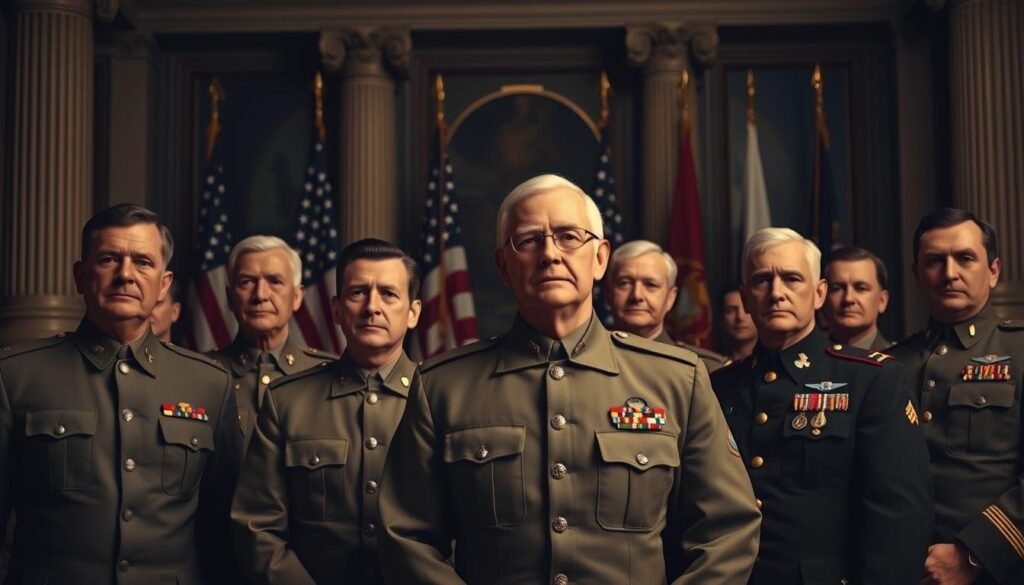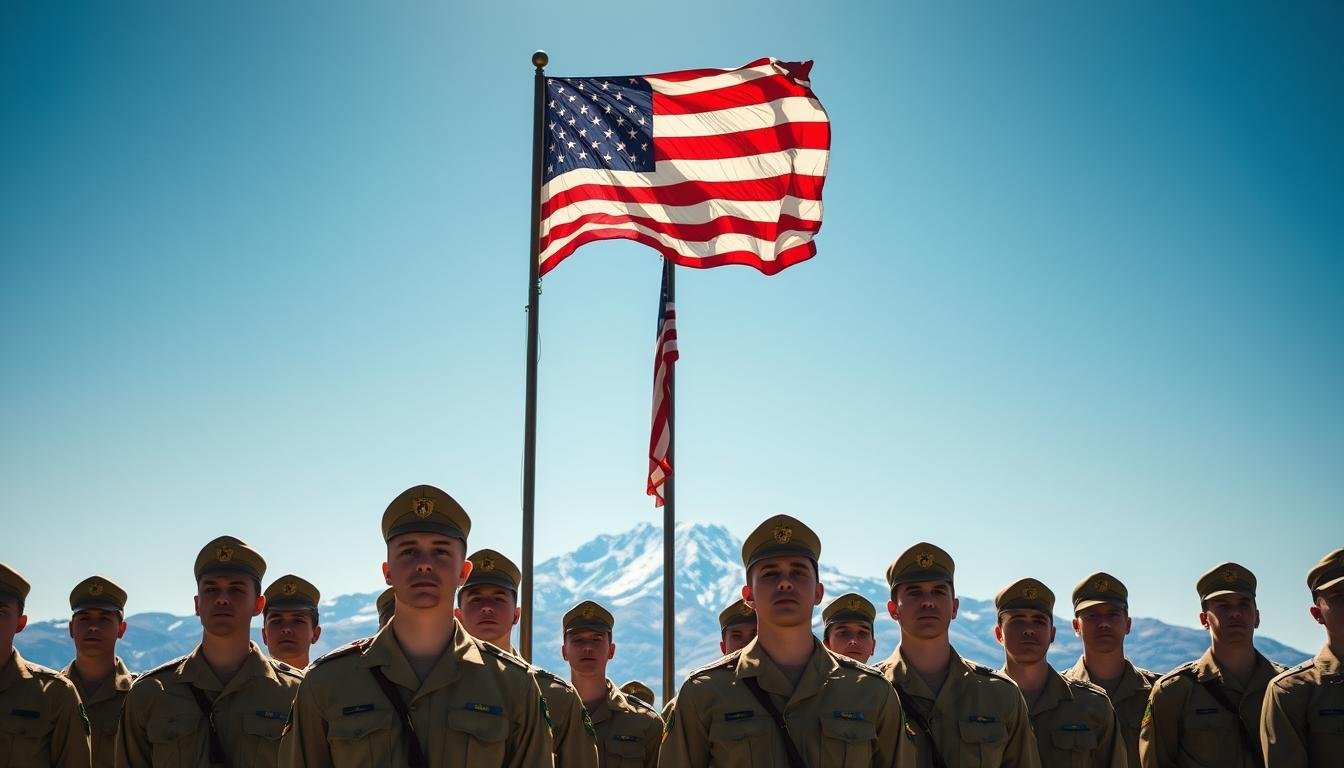Last updated on October 20th, 2025 at 11:02 am
Mormon Participation in the U.S. Armed Forces: Have you ever wondered about the connection between Mormons and the U.S. military? The story of Mormon military service is rich and complex. It shows the community’s values and the hurdles they’ve overcome.
As you delve into this topic, you’ll learn about the special role of LDS military participation. You’ll see how Mormon service members have made a difference in the U.S. Armed Forces. You’ll also understand the support they receive and the obstacles they encounter.
By looking at the past and present of Mormon military involvement, you’ll get a clearer picture. This will help you understand this vital part of American life. [Mormon Participation in the U.S. Armed Forces]
Contents
- 1 The Historical Relationship Between Mormons and Military Service
- 2 Do Mormons Serve in the Military? Understanding Current Participation
- 3 Mormon Religious Beliefs and Military Service
- 4 Unique Aspects of Mormon Military Service
- 5 Challenges Faced by Mormon Service Members
- 6 Notable Mormon Military Leaders and Heroes
- 7 Support Systems for Mormon Military Personnel and Families
- 8 Conclusion: Mormon Participation in the U.S. Armed Forces
- 9 FAQ
- 9.1 What is the historical context of Mormon participation in the U.S. Armed Forces?
- 9.2 How do Mormon participation rates in the military compare to the general population?
- 9.3 How are Mormons distributed across different military branches?
- 9.4 What is the representation of Mormons as officers versus enlisted personnel in the military?
- 9.5 How do Mormon religious beliefs influence their approach to military service?
- 9.6 What unique challenges do Mormon service members face while serving in the military?
- 9.7 What support systems are available to Mormon military personnel and their families?
- 9.8 Are there any notable Mormon military leaders or heroes?
- 9.9 How do Mormon service members maintain their religious practices while serving in the military?
The Historical Relationship Between Mormons and Military Service
Mormon history is closely tied to the U.S. military’s history. This bond has seen both cooperation and conflict. Key events and figures help us understand this complex relationship.
The Nauvoo Legion
The Nauvoo Legion was a Mormon militia from the 1840s in Nauvoo, Illinois. It was crucial for the community’s defense and got involved in local disputes.
Conflicts with the U.S. Government
There were many conflicts between Mormons and the U.S. government, especially during the Utah War (1857-1858). These issues shaped how Mormons viewed military service.
| Event | Date | Impact |
|---|---|---|
| Formation of Nauvoo Legion | 1840s | Community defense |
| Utah War | 1857-1858 | Increased tensions with U.S. government |
Formation and Purpose
The Nauvoo Legion was created to protect the Mormon community. Its formation showed the need for self-defense because of conflicts with others.
Impact on Mormon-U.S. Relations
The long-standing conflicts between Mormons and the U.S. government have deeply affected their relationship. Knowing this history is key to understanding Mormon involvement in the U.S. Armed Forces.
Do Mormons Serve in the Military? Understanding Current Participation
Many wonder if Mormons are in the U.S. armed forces. The answer is yes. The Church of Jesus Christ of Latter-day Saints, known as the Mormon Church, has a big presence in the military.
Participation Rates Compared to General Population
Research shows Mormons are more likely to join the military than others. This is because of their strong values in service, patriotism, and duty. [Mormon Participation in the U.S. Armed Forces]
Distribution Across Military Branches
Mormons serve in all U.S. military branches. This includes the Army, Navy, Air Force, and Marine Corps. Their numbers are close to the military’s overall makeup.
Officer vs. Enlisted Representation
Mormons hold both enlisted and officer positions. They are more likely to become officers. This shows their focus on leadership and service.
Mormon Religious Beliefs and Military Service
Mormonism’s view on military service is rooted in its Articles of Faith. These principles guide Mormons in their decisions, including military service.
Articles of Faith and Military Service
The Articles of Faith are key to Mormon beliefs. Article 12 talks about following laws and respecting those in power. This is important for Mormons to follow military rules and commands.
| Article of Faith | Principle | Relation to Military Service |
|---|---|---|
| Article 12 | Obeying and honoring the law | Following military regulations and commands |
| Article 11 | Belief in being subject to kings, presidents, rulers, and magistrates | Respect for the chain of command in the military |
Knowing these beliefs helps us understand Mormon military service. The Articles of Faith offer a moral and ethical guide for Mormons in service.
These principles shape Mormon military service. They provide a strong foundation for their role in the U.S. Armed Forces. [Mormon Participation in the U.S. Armed Forces]
Unique Aspects of Mormon Military Service
Being a Mormon in the U.S. Armed Forces comes with special aspects. Mormon service members keep their faith alive while serving. This shows their community’s dedication to their beliefs, even in tough situations.
Timing and Deferment Considerations
Mormon service members might think about when to serve. They might ask for deferments to match up with religious events or duties.
Scripture Study and Prayer
For many Mormon service members, studying scripture and praying are key. These activities keep their faith strong, even in combat or during deployments.
Keeping the Sabbath is vital for Mormons. Even in war zones, they try to keep this day holy. But, military life can make it hard.
Here are some ways Mormon service members keep their faith:
- Attending religious services and meetings when they can
- Following dietary rules from their faith
- Studying scripture and praying on their own
- Getting support from military chaplains or religious leaders
These actions help Mormon service members stay true to their faith. They also build a community among LDS members in the military.
Challenges Faced by Mormon Service Members
Military service and Mormon faith can be tough to mix. As a Mormon in the military, you might struggle with following your faith’s rules.
Dietary Considerations (Word of Wisdom)
The Word of Wisdom is a health code for Mormons. It bans alcohol, tobacco, and hot drinks. For Mormon service members, sticking to this diet can be hard, especially in the military.
It’s tough to avoid these substances at social events or in certain jobs. But, many find help in their unit’s programs. These offer non-alcoholic drinks and fun activities.
| Dietary Restriction | Challenge | Support |
|---|---|---|
| Avoiding Alcohol | Social pressures during unit gatherings | Morale programs offering non-alcoholic beverages |
| No Tobacco | Stress and peer influence | Cessation programs and support groups |
| No Hot Beverages | Limited options in dining facilities | Personal preparation of alternative beverages |
Temple Garment Wear During Service
Mormon service members wear temple garments as a faith symbol. These garments are a personal and private matter. [Mormon Participation in the U.S. Armed Forces]
Wearing them can sometimes lead to misunderstandings. Yet, many find ways to wear them discreetly while serving.
Alcohol, Tobacco, and Social Pressures
There’s a lot of pressure to drink alcohol or smoke in the military. Mormon service members lean on their faith and Mormon friends for support.
By staying connected with their faith community, they handle these challenges better. They find peers who share their beliefs. [Mormon Participation in the U.S. Armed Forces]
In summary, Mormon service members face unique challenges. Understanding and supporting these issues helps create a more welcoming military for all faiths.
Notable Mormon Military Leaders and Heroes
The history of Mormon involvement in the U.S. military is filled with bravery and leadership. You can learn about the big roles Mormons played in different wars and roles.
Civil War to World War II
Mormons served in many ways during the Civil War, facing unique challenges because of their beliefs. By World War II, Mormon soldiers had made a big impact in many places. Notable leaders emerged during this time, paving the way for future generations.
Medal of Honor Recipients
Mormon soldiers have received the Medal of Honor for their bravery in battle. These heroes show the courage and sacrifice that define Mormon military service. Below is a list of some of these recipients.
| Name | Conflict | Award |
|---|---|---|
| John Henry Kruch | World War I | Medal of Honor |
| Darrel Lindsey | World War II | Medal of Honor |

Mormons have reached high ranks in the U.S. military, showing their skill and commitment. These officers have been key in shaping military strategies and leading troops. You can find out more about their achievements and how they’ve influenced military history.
- General John M. Schofield, though not a Mormon himself, had significant interactions with Mormon leaders.
- General James L. Doolittle is an example of a high-ranking officer with Mormon background.
Support Systems for Mormon Military Personnel and Families
The Mormon community has a strong support system for its military members and their families. This support is key in helping them face the challenges of military life. [Mormon Participation in the U.S. Armed Forces]
Military Relations Committee
The Military Relations Committee is crucial. It connects Mormon service members with local church leaders and resources. This committee helps with communication and various needs during military service.
Service Member Group Activities
Service member group activities build a sense of community and camaraderie. These activities include social events and spiritual gatherings. They give service members a chance to connect with others who share their experiences and values.
Ward and Stake Programs
Ward and stake programs support Mormon service members and their families. They offer emotional support, spiritual guidance, and practical help. These programs ensure service members stay connected to their local congregation, even when far away.
Long-Distance Ministering Efforts
Long-distance ministering efforts help church members support service members who are far away. This includes regular communication, prayer, and emotional and spiritual support.
| Support System | Description | Benefits |
|---|---|---|
| Military Relations Committee | Connects service members with local church leaders and resources | Facilitates communication, provides assistance |
| Service Member Group Activities | Offers community and camaraderie among service members | Social events, spiritual gatherings |
| Ward and Stake Programs | Provides emotional, spiritual, and practical support | Emotional support, spiritual guidance, practical assistance |
| Long-Distance Ministering Efforts | Provides support to geographically distant service members | Regular communication, prayer, emotional and spiritual support |
You can find comfort and support through these programs and resources. They are designed for Mormon military personnel and their families. [Mormon Participation in the U.S. Armed Forces]
Conclusion: Mormon Participation in the U.S. Armed Forces
Mormons have played a big role in the U.S. Armed Forces. Their history with military service has grown, and they still play a big part today. Mormon beliefs often match military values, showing a strong sense of duty and love for country.
Mormon service members face unique challenges, but they’ve made big contributions to the military. The LDS Church’s support is key in helping them through their careers. This support helps them overcome obstacles and succeed.
The Mormon military legacy shows the LDS community’s long-term commitment to serving their country. Looking back at Mormon history in the U.S. military, it’s clear their impact will last for many years. Their service and legacy will continue to shape the LDS military tradition.
See Also: Do Mormons Believe in Santa Claus?
FAQ
What is the historical context of Mormon participation in the U.S. Armed Forces?
Mormons and the U.S. military have a complex history. It includes conflicts and the creation of the Nauvoo Legion, a Mormon militia.
How do Mormon participation rates in the military compare to the general population?
Mormons are known for their high military participation. This shows how involved they are compared to others.
How are Mormons distributed across different military branches?
Mormons are found in all military branches. This shows their diverse roles in the armed forces.
What is the representation of Mormons as officers versus enlisted personnel in the military?
Mormons hold both officer and enlisted positions. This highlights their leadership and service in the military. [Mormon Participation in the U.S. Armed Forces]
How do Mormon religious beliefs influence their approach to military service?
Mormon beliefs, as stated in the Articles of Faith, guide their military service. These beliefs shape their practices and values.
What unique challenges do Mormon service members face while serving in the military?
Mormon service members face special challenges. These include following the Word of Wisdom, wearing temple garments, and avoiding alcohol and tobacco.
What support systems are available to Mormon military personnel and their families?
The Mormon community offers many supports. This includes the Military Relations Committee, group activities, and programs for wards and stakes. They also have efforts for long-distance ministering.
Are there any notable Mormon military leaders or heroes?
Yes, Mormons have made significant contributions to the military. This includes Medal of Honor winners and high-ranking officers. Their stories show their bravery and sacrifices.
How do Mormon service members maintain their religious practices while serving in the military?
Mormon service members keep their faith through scripture study and prayer. They also observe the Sabbath in combat zones. These actions highlight their commitment to their faith.

Ramona Pearson from the USA is an experienced religious researcher and writer with over 10 years studying Mormon history, beliefs, and culture. She creates accurate, insightful content to educate and inform curious readers worldwide.

